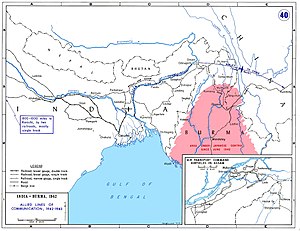
Back La gepa Catalan The Hump Czech The Hump Danish The Hump German La Joroba (The Hump) Spanish هامپ FA The Hump French The Hump Croatian The Hump ID The Hump NB
| The Hump | |
|---|---|
| Part of the Burma Campaign of World War II | |
 Allied lines of communication in Southeast Asia (1942–43). The Hump airlift is shown at upper right. | |
| Location | |
| Planned | November 1941[1] |
| Planned by | Republic of China Air Force, United States Army Air Forces, Royal Air Force, ABDA Command |
| Objective | Resupplying the Chinese war effort |
| Date | April 8, 1942 – November 1945 |
| Executed by | Tenth Air Force, India-China Division, XX Bomber Command |
| Outcome | Allied operation successful |
| Casualties |
|
| The Hump | |||||||
|---|---|---|---|---|---|---|---|
| Traditional Chinese | 駝峰航線[2] | ||||||
| Simplified Chinese | 驼峰航线 | ||||||
| Literal meaning | Hump Route | ||||||
| |||||||
The Hump was the name given by Allied pilots in the Second World War to the eastern end of the Himalayan Mountains over which they flew military transport aircraft from India to China to resupply the Chinese war effort of Chiang Kai-shek and the units of the United States Army Air Forces (USAAF) based in China. Creating an airlift presented the USAAF a considerable challenge in 1942: it had no units trained or equipped for moving cargo, and there were no airfields in the China Burma India Theater (CBI) for basing the large number of transport aircraft that would be needed. Flying over the Himalayas was extremely dangerous and made more difficult by a lack of reliable charts, an absence of radio navigation aids, and a dearth of information about the weather.[3]
The task was initially given to the USAAF's Tenth Air Force, and then to its Air Transport Command (ATC). Because the USAAF had no previous airlift experience as a basis for planning, it assigned commanders who had been key figures in founding the ATC in 1941–1942 to build and direct the operation, which included former civilians with extensive executive experience operating civil air carriers.[4]
Originally referred to as the "India–China Ferry",[5] the successive organizations responsible for carrying out the airlift were the Assam–Burma–China Command[a] (April–July 1942) and the India-China Ferry Command (July–December 1942) of the Tenth Air Force; and the Air Transport Command's India-China Wing (December 1942 – June 1944) and India-China Division (July 1944 – November 1945).
The operation began in April 1942, after Japanese forces blocked the Burma Road, and continued daily until scaled down from August 1945. It procured most of its officers, men, and equipment from the USAAF, augmented by British, British-Indian Army, Commonwealth forces, Burmese labor gangs and an air transport section of the Chinese National Aviation Corporation (CNAC). Final operations were flown in November 1945 to return personnel from China.
The India–China airlift delivered approximately 650,000 tons of materiel to China at great cost in men and aircraft during its 42-month history.[6] For its efforts and sacrifices, the India–China Wing of the ATC was awarded the Presidential Unit Citation on 29 January 1944 at the personal direction of President Franklin D. Roosevelt,[7] the first such award made to a non-combat organization.[8]
- ^ Plating, John D. (8 February 2011). The Hump: America's Strategy for Keeping China in World War II. Texas A&M University Press. p. 38. ISBN 9781603442374.
- ^ ""駝峰航線"上的年輕勇士(東方主戰場·記憶)——記為中國抗戰犧牲的美國飛行員詹姆斯·布朗--時政--人民網". politics.people.com.cn.
- ^ Cite error: The named reference
jtcwas invoked but never defined (see the help page). - ^ Tunner 1955, pp. 19–20.
- ^ Weaver & Rapp 1944, p. 35.
- ^ Launis 2000, p. 110.
- ^ Weaver & Rapp 1944, p. 131.
- ^ Launis 2000, p. 111.
Cite error: There are <ref group=lower-alpha> tags or {{efn}} templates on this page, but the references will not show without a {{reflist|group=lower-alpha}} template or {{notelist}} template (see the help page).